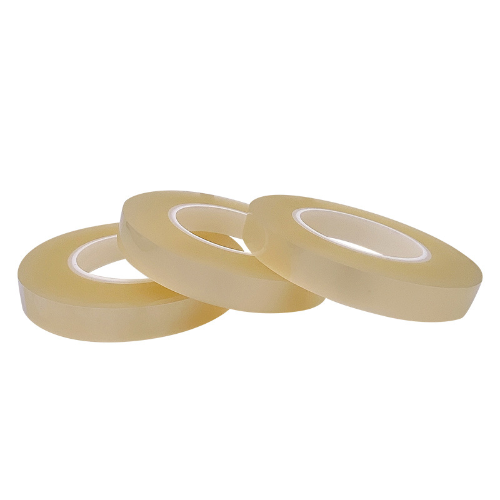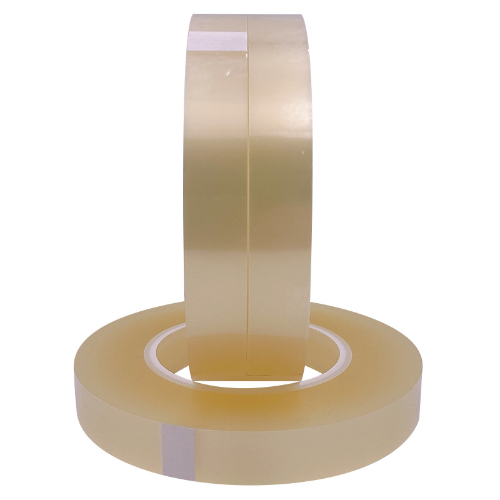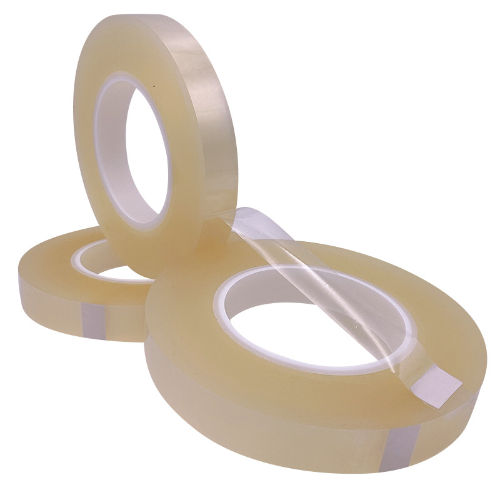



Lithium battery expansion tape
Using OPS resin film as the base material and coated with a special adhesive, this tape possesses certain scratch-resistant capabilities. After the battery cell is inserted into the shell during the manufacturing process, the expansion tape will undergo appropriate expansion under certain high temperatures and the action of the electrolyte, connecting the inner cell and the outer steel shell into one integrated unit
Detailed description
After the battery cell is inserted into the shell, under certain high temperatures and the action of the electrolyte, the tape will undergo appropriate expansion to fill the gap between the cell and the shell, integrating the cell and the shell into one unit. This prevents movement between the cell and the shell during battery vibration, resolving issues such as battery short circuits and circuit breaks caused by vibration.
Related Specifications
| Effective Width (mm) | Subject to actual shipment specifications | ||
|---|---|---|---|
| Inspection Item | Unit | Spec. Value | Test Method |
| Dimension & Tolerances | |||
| 1. Color | Transparent | ||
| 2. Thickness | mm | 0.041±0.005 | GB/T 7125-1999 |
| 3. Inside Diameter of Roll | mm | 77±1 | |
| 4. Length | m | 100 | |
| Composition | |||
| 1. Backing | OPS | ||
| 2. Backing Thickness | mm | 0.040 | GB/T 7125-1999 |
| 3. Glue | Acrylic Adhesive | ||
| Physical & Chemical Properties | |||
| 1. 180° Adhesion | N/25mm | ≥1 | GB/T 2792-1998 |
| 2. Thickness Expansion Coefficient of Electrolyte Resistance | % | Soaking in electrolyte at room temperature for 12H, expansion 200↑ Soaking in electrolyte at 85℃ for 2H, thickness expansion 200↑ |
GB/T 2792-1998 |
| 3. Tensile Strength | N/10mm | ≥10 | GB/T 7753-87 |
FAQ
High-temperature tape is a specialized adhesive tape capable of maintaining its adhesiveness, insulating properties, or sealing capabilities under high-temperature environments.
- Exceptional Heat Resistance: This is the most defining feature. Depending on the material and design, high-temperature tapes can withstand temperatures ranging from approximately 120°C (250°F) to over 300°C (570°F), with specialized types even enduring above 500°C. This enables stability during high-temperature processes like manufacturing, soldering, or repairs.
- High-Temperature Adhesive Performance: Not only the base material but also the specialized adhesive must retain its bond strength without melting, decomposing, or losing adhesion under extreme heat.
- Stability: Resists shrinkage, deformation, brittleness, or emission of harmful gases when exposed to prolonged high temperatures
Polyimide (PI):
Excellent high-temperature resistance (typically continuous use at 260°C/500°F, with higher short-term tolerance), electrical insulation, chemical stability, and mechanical strength. Widely used in electronics and electrical applications.
Example: PI tapes shield PCB gold fingers during soldering (peak: 300°C) and insulate transformers
Fiberglass Cloth:
Woven fiberglass coated with high-temperature silicone adhesive. Offers heat resistance (180–260°C), flame retardancy, insulation, and moderate strength/abrasion resistance. Ideal for thermal insulation, bundling, and sealing.
Example: Reinforced fiberglass tapes withstand 220°C long-term in H-class transformers and lithium battery insulation
Polytetrafluoroethylene (PTFE/Teflon):
Extremely low friction coefficient (non-adhesiveness), exceptional chemical resistance, and sustained heat tolerance (~260°C). Primarily used in anti-stick or corrosive environments.
Example: PTFE tapes line food packaging heat-sealing rollers and industrial conveyor belts exposed to acids/alkalis
Aluminum Foil:
Foil laminated with heat-resistant adhesives (acrylic or silicone). Provides thermal insulation, moisture/EMI shielding, and sealing. Common in HVAC ducting, automotive systems, and electronic enclosures.
Example: Aluminum foil tapes seal air-conditioning pipes and shield electromagnetic interference in transformers
Lithium Battery Expansion Tape is a functional tape designed specifically for lithium-ion batteries (especially cylindrical batteries). It plays a very important role in battery manufacturing and use, mainly improving battery safety and stability.
Lithium battery expansion tape is a key auxiliary material for ensuring the safety and performance of lithium batteries. Its core features are designed around the battery’s operating environment (such as high temperatures and electrolyte corrosion) and functional requirements (such as sealing, cushioning, and short-circuit protection). These features include the following:
1. Precisely controllable expansion performance
This is its core function: when exposed to heat (such as abnormal battery temperatures exceeding 80-150°C) or contact with electrolyte, it expands rapidly and evenly (typically 2-5 times its original thickness, with some specialized models exceeding 10 times), filling internal gaps in the battery (such as those between the electrode stack and the casing, and between the tab and the cover), providing sealing, cushioning, and securing the battery, preventing electrolyte leakage and electrode stack movement.
2. Excellent high-temperature resistance
The normal operating temperature of a lithium battery is approximately 20-60°C, but under abnormal conditions, temperatures may rise above 100°C, even approaching 200°C. Expandable tape must withstand temperatures within this range (long-term resistance ≥ 120°C, short-term resistance ≥ 180°C), not melt or decompose at high temperatures, and its expansion function must remain intact, ensuring continued performance under extreme operating conditions.
3. Electrolyte Corrosion Resistance
Lithium battery electrolytes are mostly carbonate-based organic solvents (such as EC and DMC). The base material of the expandable tape (such as modified acrylate or rubber-based adhesive) must be chemically inert and not swell, dissolve, or react with the electrolyte to ensure long-term stability.
4. Reliable Adhesion
It must firmly adhere to the battery casing (aluminum or steel), the electrode assembly separator (PP/PE), or the tab (copper or aluminum), without peeling off before or after expansion. The adhesive’s initial tack and sustained adhesion must be compatible with the battery assembly process (such as room temperature lamination and light pressure curing). 5. Insulation and Voltage Resistance
The tape itself must be made of an insulating material (volume resistivity ≥ 10¹⁴Ω・cm) capable of withstanding the battery’s internal operating voltage (3-5V) to prevent short circuits between the electrode assembly and the casing, while maintaining its insulation properties even after expansion.
6. Thinness and Dimensional Stability
The original thickness is typically 0.05-0.3mm, meeting the miniaturization and high energy density requirements of lithium batteries. It is also less susceptible to shrinkage and warping during storage and use, ensuring precise cutting and lamination.
These properties ensure that the expansion tape remains invisible during normal lithium battery operation and responds quickly to risks such as abnormal temperature rise and gas production, thereby enhancing battery safety and service life.
Substrate layer (or base layer): This layer serves as the tape’s backbone, primarily providing insulation and mechanical strength. Common materials include polyester film, OPS, BOPP, BOPA, BOPET, CPP, TPU, PLA, and PO.
Expansion layer: This is the core functional layer of the expansion tape, responsible for volume expansion upon contact with the battery electrolyte. This layer is typically composed of polymers that swell with the electrolyte, such as oriented polystyrene and polyacrylic acid. Some patents also mention adhesives with “water-based self-healing” properties.
Glue layer: This layer securely secures the expansion tape to the battery cell. Research has shown that acrylic glue is a commonly used glue, which exhibits good electrolyte resistance and strong adhesion.
The expansion mechanism of expansion tapes is similar to that of super absorbent polymers (SAPs). These polymers contain numerous hydrophilic functional groups (such as carboxylic acid groups). When immersed in electrolyte, osmotic pressure drives solvent molecules into the polymer network, causing the molecular chains to stretch and expand.
1. Filling and Sealing Internal Battery Gap
During lithium battery assembly, tiny gaps exist between the electrode assembly (cell stack) and the casing (aluminum or steel), between the tabs and the cover, and between the cover and the casing, potentially leading to electrolyte leakage or moisture intrusion.
The expansion tape is applied to these gaps. After the battery is packaged (due to heat or contact with electrolyte), it expands, tightly filling the gaps and forming a “dynamic seal”—preventing electrolyte leakage and isolating moisture from entering, ensuring a stable battery chemical environment.
2. Electrode Assembly Stabilization and Vibration Control
The electrode assembly is the core of a lithium battery (composed of a stacked/wound positive electrode, negative electrode, and separator). If it shakes inside the casing, it can cause electrode misalignment, separator damage, and potentially short circuits. Expandable tape is affixed to the side or bottom of the electrode assembly. After expansion, it creates a “compression force” that secures the electrode assembly firmly within the housing, preventing displacement due to vibration and impact. Its elastic material also cushions external forces (such as drops and collisions), minimizing damage from rigid collisions between the electrode assembly and the housing.
3. Insulation and Isolation to Prevent Short Circuits
The lithium battery housing (metal) and electrode assembly, as well as the tabs (metal) and housing, must be strictly insulated. Otherwise, conductive contact can cause a short circuit.
The expandable tape itself is an insulating material (such as a PET substrate + insulating adhesive). Under normal conditions, it can isolate metal components. After expansion, its increased volume further widens the insulation distance, preventing the risk of “edge conductive contact” caused by micro-deformation of the electrode assembly during battery charging and discharging.
4. Safety Aid in the Early Stages of Thermal Runaway
When a lithium battery experiences thermal runaway, the internal temperature rises rapidly (up to 100-200°C) and gases expand, potentially causing the housing to rupture or explode. Expansion tape rapidly expands at high temperatures (e.g., 80-150°C). This fills the extra space created by gas expansion within the casing, relieving localized pressure. Furthermore, the expanded adhesive layer wraps around the edges of the electrode stack, slowing heat transfer to adjacent cells and buying time for the battery management system (BMS) to trigger protective mechanisms.
5. Customizable to Different Battery Types
Prismatic aluminum/steel case batteries: Primarily used to fill gaps between the electrode stack and the casing, and to seal tab holes in the cover plate;
Cylindrical batteries: Commonly used to secure cells to the module holder, or as a buffer between cells;
Soft-pack batteries: Attached to the edges of the aluminum-plastic film, expansion strengthens the seal and prevents leakage around the edges.
